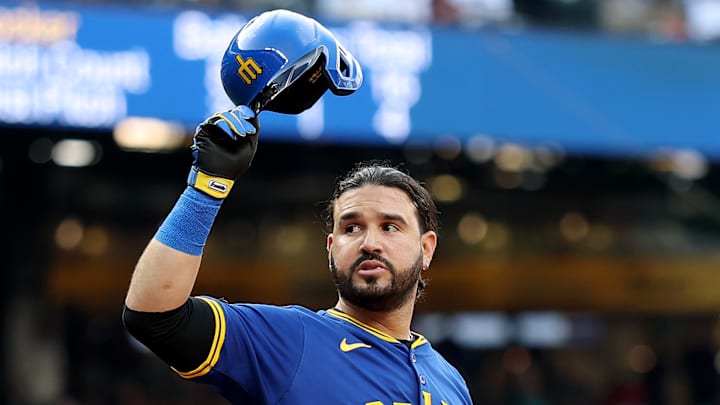Not every trade deadline win comes from being the most aggressive. Sometimes, the smartest decision is knowing when to walk away.
That’s the position the Milwaukee Brewers find themselves in right now, watching from afar as Eugenio Suárez struggles to make contact in his return to Seattle. The Brewers were connected to the veteran slugger in the weeks leading up to the deadline, as Arizona shopped him to contenders in need of third-base pop. The Diamondbacks reportedly wanted a sizable return: controllable, top-tier prospects for a rental bat.
Milwaukee, to their credit, didn’t bite. And six games into Suárez’s second stint with the Mariners, they’re probably feeling like geniuses.
Suárez has gone 2-for-24 since rejoining Seattle. That’s a .083 batting average with 11 strikeouts, and a home run across his first six games. He’s looked out of sync and overmatched, far from the middle-of-the-order threat Arizona was shopping.
Why the Brewers were wise to skip the Eugenio Suárez sweepstakes
If you’re the Brewers, you’re asking yourself: What happens if you pay that steep price, plug him into the heart of your lineup, and this is the return? The narrative would’ve shifted fast — from “deadline upgrade” to “costly misfire.”
There were some predictable red flags here, and it’s not just small sample struggles. There were clear indicators that Suárez’s bat might not play the same way in Milwaukee. He went from Chase Field, which ranks 3rd in MLB in Park Factor (104), to T-Mobile Park, dead last among qualified stadiums with a 91 Park Factor. Despite T-Mobile Park’s cavernous reputation, Suárez managed to put together fairly even home-and-away splits during his 2022–2023 tenure with the Mariners. He didn’t necessarily thrive at home, but he held his own.
Suárez’s numbers tell the story. Here’s how he’s performed in recent seasons based on location, starting with 2022 and 2023 as a Mariner:
- 2022 home splits: .233/.335/.448, 16 HR, 43 RBI | OPS+: 117
- 2022 away splits: .239/.329/.470, 15 HR, 44 RBI | OPS+: 128
- 2023 home splits: .232/.331/.441, 12 HR, 48 RBI | OPS+: 100
- 2023 away splits: .233/.315/.374, 10 HR, 48 RBI | OPS+: 92
Steady, solid, nothing eye-popping. Now compare that to his Arizona breakout:
- 2024 home splits: .274/.331/.522, 18 HR, 53 RBI | OPS+: 134
- 2024 away splits: .239/.308/.422, 12 HR, 48 RBI | OPS+: 107
- 2025 home splits: .241/.319/.614, 25 HR, 54 RBI | OPS+: 150
- 2025 away splits: .236/.296/.487, 12 HR, 36 RBI | OPS+: 118
That’s a legitimate star-level hitter at home, with top-tier power production. Even on the road, he remained well above average. But Chase Field clearly boosted his ceiling.
American Family Field ranks only slightly better than T-Mobile Park with a Park Factor of 96 (26th out of 28 qualified parks — note that the Athletics and Rays are excluded since they’re not playing in their permanent home stadiums this season). It’s no secret that the Brewers’ home park leans pitcher-friendly, particularly in suppressing batting average and OBP. And while the longball can fly in Milwaukee more than it does in Seattle, it’s nowhere close to what hitters enjoy in the desert.
The Brewers roster is already tight on positional flexibility; adding Suárez would’ve created more questions in how to play Caleb Durbin and Joey Ortiz than answers. Especially if the production cratered outside of Arizona. Milwaukee would’ve not only risked their clubhouse chemistry but also their long-term farm strength.
Instead, they stayed disciplined. They held onto their young arms and rising bats. And while Suárez might heat up again, the early returns suggest Milwaukee avoided one of the most regrettable swings of the 2025 trade deadline.
The Brewers’ front office has made a name for itself by being smart, not splashy. They don’t chase headlines. They play the long game. And in this case, that patience and restraint might’ve just saved them from a PR nightmare and a lineup logjam.
While other teams are scrambling to justify what they gave up, Milwaukee gets to keep developing its core without any buyer’s remorse.
